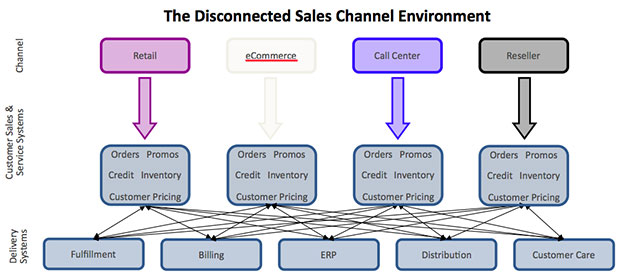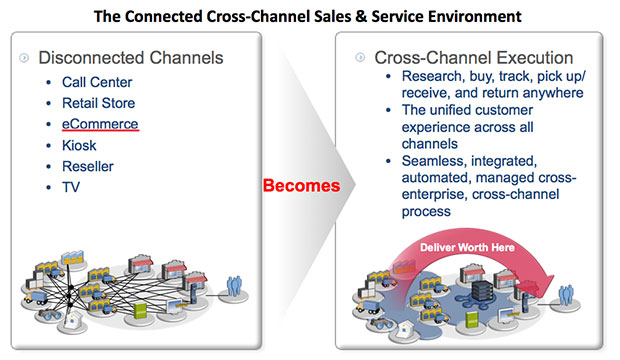
Over the past few years, we have seen a seismic shift in the relationship between sellers and consumers, with the power shifting to the consumer. Customers have always wanted exactly what they want, when they want it, at a great price. With today’s technology, however, they have near total control over business.
They can make or break a seller’s brand at the click of a mouse. In return, they expect to get the best price, easily find a product or service that meets their EXACT needs, and top-shelf service 24 hours a day. To deliver on these promises, companies must deliver a cross-channel buying experience.
What Is a Cross-Channel Buying Experience?
Today’s consumers expect a richer and simpler buying experience, one in which a business’ sales and interaction channels work in unison to allow the customer to easily traverse multiple channels to complete specific parts of an order. Unfortunately, most sellers do not have in place the systems infrastructure to enable a cross-channel buying experience.
In many operations, it is quite common to find that each sales and service channel has its own set of customer, offer and order information. Hence, each channel operates like its own unique business, as depicted in Figure 1 below.
This disconnected sales channel environment usually creates an inconsistent sales experience for the customer, as available sales information and processes may be totally unique to each channel. This inhibits the seller from creating a consistent and compelling brand experience across all channels and contributes to loss of brand identity.

What customers expect now is a consistent experience across all sales channels — research at any channel, access to their customer information, consistent presentation of offers and promotions and the ability to handle one order across channels.
In the connected cross-channel world, individual channel systems may exist, but all customer, ordering and offer/promotion data, logic and processing are unified to provide the customer with a seamless cross-channel interaction.

Take the example of a customer buying the latest smartphone. She researches the smartphone online, starts and saves the partial order, and then visits a retail store to test the device.
In the store, she reviews associated voice and data rate plans and works with the retail store associate, who can access the partial order, to complete it. The associate finds that the phone is out-of-stock in the store but arranges for the phone to be shipped to her house for next-day delivery.
Upon returning home, she remembers she forgot to order a special accessory her husband asked for — and realizes she selected the wrong data plan. She calls the call center, where the representative accesses the in-progress order, adds the accessory, and changes the data plan so the smartphone arrives just as the customer wanted.
In the end, a cross-channel buying experience helps build superior customer experience by being
- Constant: 24/7 customer access to sales and service via channels spanning human, social, digital and mobile interactions
- Continuous: extends beyond individual transactions to the lifecycle of a sale as it crosses channels
- Comprehensive: supports not only initial sale but also fulfillment and service options
Implementing the Cross-Channel Buying Experience
To deliver this cross-channel buying experience, sellers must implement key technologies that will enhance the purchase lifecycle while leveraging legacy contact channel environments. What does this mean?
Sellers must ensure the customer’s interactions are supported by timely, consistent and relevant information to handle the customer’s request as the request traverses multiple channels — call center, retail store, e-commerce, kiosk and even resale partners.
This also means sellers must invest in systems that support the collection, management and application of customer, offer and order information consistently across all of the seller’s sales and service channels. With the right data available at the right time, sellers are armed to deliver a superior cross-channel buying experience.
Key technologies in delivering this cross-channel buying experience:
- A Single Customer Information Platform – Provides a single view of the customer across all online and offline channels, including the latest customer activity, and covers both sales and service activities. Supports capturing information from all sales channels and customer touchpoints to provide unprecedented customer awareness.
- Cross-Channel Offer Presentation – Enables a seller to centrally define and then present offers and promotions consistently across all sales channels. While it allows channel-specific offers, such as an Internet-only promotion, the goal is to ensure a customer can find, view and purchase the same offer consistently across all channels at the same time.
- Cross-Channel Order Hub – The heart of the cross-channel execution environment, the cross-channel order hub provides the integration services, business logic, shopping flows and data stores that support order processing across any channel for any order type, including change orders, throughout the completion of the order lifecycle. It should be extensible to consider cross-channel fulfillment processes such as buy online and pick-up in store.
- Cross-Channel Inventory Visibility – Provides consistent views into inventory across multiple inventory sources to enable cross-channel fulfillment processes such a buy online and pick-up in the preferred retail store.
- Cross-Channel Analytics – Uses customer and prospect behavior and information captured across online and offline channels to more intelligently target offers and messages as the customer traverses different channel and touchpoints.
Enabling customers to shop seamlessly and easily across channels and touchpoints is a critical part of delivering a superior customer experience that can help to strengthen revenue streams.
Within the cross-channel buying experience, customers have the freedom to achieve their goals throughout the buying process. By leveraging advanced cross-channel technologies, companies can make the buying experience richer and simpler for the customer, while optimizing their own processes so both the seller and buyer win.












































